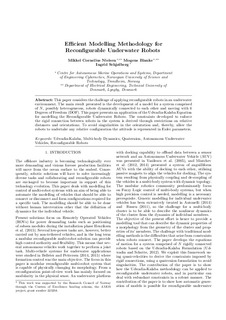| dc.contributor.author | Nielsen, Mikkel Cornelius | |
| dc.contributor.author | Blanke, Mogens | |
| dc.contributor.author | Schjølberg, Ingrid | |
| dc.date.accessioned | 2016-11-07T10:52:20Z | |
| dc.date.accessioned | 2016-11-23T13:25:55Z | |
| dc.date.available | 2016-11-07T10:52:20Z | |
| dc.date.available | 2016-11-23T13:25:55Z | |
| dc.date.issued | 2016 | |
| dc.identifier.citation | IFAC-PapersOnLine 2016, 49(23):74-80 | nb_NO |
| dc.identifier.issn | 2405-8963 | |
| dc.identifier.uri | http://hdl.handle.net/11250/2422695 | |
| dc.description.abstract | This paper considers the challenge of applying reconfigurable robots in an underwater environment. The main result presented is the development of a model for a system comprised of N, possibly heterogeneous, robots dynamically connected to each other and moving with 6 Degrees of Freedom (DOF). This paper presents an application of the Udwadia-Kalaba Equation for modelling the Reconfigurable Underwater Robots. The constraints developed to enforce the rigid connection between robots in the system is derived through restrictions on relative distances and orientations. To avoid singularities in the orientation and, thereby, allow the robots to undertake any relative configuration the attitude is represented in Euler parameters | nb_NO |
| dc.language.iso | eng | nb_NO |
| dc.publisher | Elsevier for IFAC | nb_NO |
| dc.title | Efficient Modelling Methodology for Reconfigurable Underwater Robots | nb_NO |
| dc.type | Journal article | nb_NO |
| dc.type | Peer reviewed | nb_NO |
| dc.date.updated | 2016-11-07T10:52:20Z | |
| dc.source.pagenumber | 74-80 | nb_NO |
| dc.source.volume | 49 | nb_NO |
| dc.source.journal | IFAC-PapersOnLine | nb_NO |
| dc.source.issue | 23 | nb_NO |
| dc.identifier.doi | 10.1016/j.ifacol.2016.10.324 | |
| dc.identifier.cristin | 1396776 | |
| dc.relation.project | Norges forskningsråd: 223254 | nb_NO |
| dc.description.localcode | author postprint | nb_NO |
